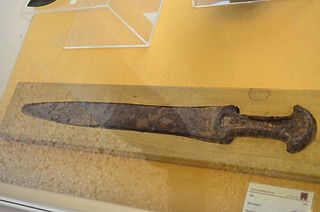 W
WThe acinaces, also spelled akinakes or akinaka is a type of dagger or short sword used mainly in the first millennium BC in the eastern Mediterranean region, especially by the Medes, Scythians and Persians, then by the Greeks.
 W
WThe Arab sword, sometimes called a Saif (سيف) or a Shamshir depending on the era, has its origins in Arabia prior to the 7th century. Not much is known about this particular weapon, other than what Al-Kindi wrote in his treatise On Swords in the 9th century.
 W
WA kilij is a type of one-handed, single-edged and moderately curved scimitar used by the Timurid Empire, Mamluk Empire, Ottoman Empire, and the later Turkic Khanates of Central Asia and Eurasian steppes. These blades developed from earlier Turko-Mongol sabers that were in use in lands invaded or influenced by the Turkic peoples.
 W
WA Mameluke sword is a cross-hilted, curved, scimitar-like sword historically derived from sabres used by Mamluk warriors of Mamluk Egypt after whom the sword is named. Egypt was, at least nominally, part of the Ottoman Empire and the sword most commonly used in Egypt was the same as used elsewhere in the empire, the kilij.
 W
WAlthough the inscription on the blade attributes it to Fathali Shah, legend and fact has it as Nader Shah's sword or his All Conquering Sword.
 W
WThe Sword of Osman was an important sword of state used during the enthronement ceremony of the sultans of the Ottoman Empire. The sword was named after Osman I, founder of the Ottoman Dynasty.
 W
WIn English the word scimitar refers to a backsword or sabre with a curved blade. Adapted from the Italian word scimitarra in the mid 16th century from an unknown source, the word became used for all 'Oriental' blades which were curved, compared to the more commonly straight and double edged European swords of the time. This is apparent in Thomas Page's The Use of the Broad Sword. Published: 1746:"The Sword was of enormous length and breadth, heavy and unweildy, design'd only for right down chopping by the Force of a strong Arm; till Time and Experience discovering the Disadvantages, by Degrees contracted its Length and lighten'd its Weight in to the more handy Form of the Scymitar; which was first invented by the Eastern Nations, and has continued to be their principal Weapon to this Day:...." "The Saracens, Turks and Persians, made use of but three different Throws with the Scymitar, and one of those, only on Horseback; the other two on Foot."
 W
WA shamshir is a type of Persian/Iranian sword with a radical curve. The name is derived from the shamshīr, which means "lion's claw or lions tale" in the Persian language. The curved "scimitar" sword family includes the shamshir, kilij, talwar, pulwar and nimcha.
 W
WZulfaqar, also spelled Zu al-Faqar, Zulfiqar, Dhu al-Faqar, Dhulfaqar or Dhulfiqar, is the sword, that the Islamic prophet Muhammad gave as a gift to Caliph Ali ibn Abi Talib. It was historically frequently depicted as a scissor-like double bladed sword on Muslim flags, and it has central importance in Sunni Islam, However in Shia Islam, it is commonly shown in Shia depictions of Ali and in the form of jewelry functioning as talismans as a scimitar terminating in two points.